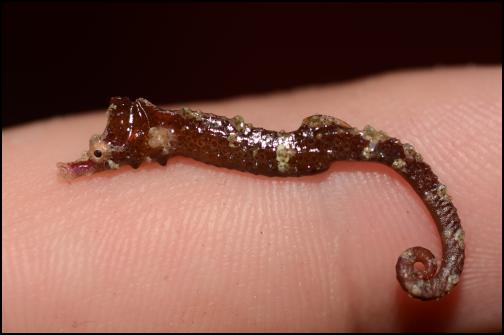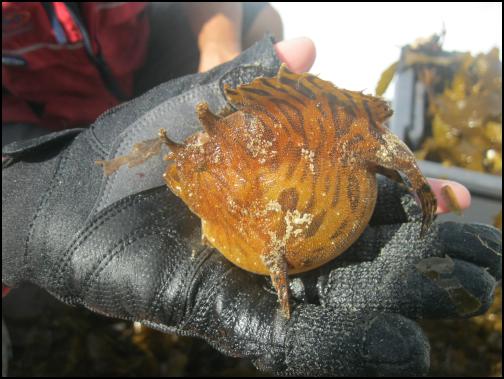Rare fish and new seafloor habitats found during NIWA survey

Rare fish and new seafloor habitats found during NIWA survey
NIWA scientists surveying shallow water coastal habitats off the east coast of Northland have found a rich diversity of macroalgal meadows, shellfish beds, sponges, and rare fish species, including a frogfish and possibly a new species of seahorse.
The survey was conducted using a small beam trawl research net with GoPro cameras attached, as well as dropped stationary cameras both with and without bait to attract fish.
Its goal was to discover what types of habitats were present and where they occurred; and what juvenile and small fish were associated with them. The information gathered will ultimately help inform fishery and ecosystem management decisions.
NIWA marine ecologist Dr Meredith Lowe says the resulting information helps to fill in gaps in scientific knowledge about biogenic habitats in particular – "living" habitats created by plants and animals - and their small fish inhabitants, such as juvenile snapper. The survey results are helping to build a national fish-habitat classification and inventory of New Zealand’s coastal and shelf zone.
“Our knowledge of what lives in the coastal zone is scant. For instance, while we believe estuaries provide critical nurseries for a range of fish species, we cannot prove that until we know their relative contributions compared to possible alternative coastal nursery areas. During our survey, ‘new’ snapper nurseries and associated habitats were found in Te Rawhiti Strait, Bay of Islands, and in inner Doubtless Bay. We can now combine these data with previously collected estuary data to estimate what the relative nursery values are.
“We also know this coastal region is one of the most species diverse nationally, and this work has shown that this rich diversity also extends to seafloor habitat types, and the fish species which live in them. As an additional bonus, a number of new species of red algae were also discovered."

Frogfish
The use of GoPro cameras is a new science technology development for the team, developed from NIWA technician Crispin Middleton’s strong interests in underwater photography (having won several underwater photography competitions). Video from the cameras revealed some surprises, with a juvenile white shark bumping into the camera bait pot as it swam past, and a group of dolphins talking to each other as they checked out the sampling net down on the seafloor under tow.
The seahorse is undergoing scientific identification to assess whether it is a new species.
Dr Lowe says it will be some time before scientists can confirm its identity and how rare it is worldwide. It is about 3 cm long and predominantly brown in colour.
Meanwhile, the Ministry for Primary Industries has just released a report that reviews existing knowledge about fisheries species and their linkages to biogenic habitats.
It is hoped the review, written by NIWA [available at http://www.mpi.govt.nz/news-resources/publications], will help act as a catalyst for future management initiatives which include the role of these habitats and take into account how they are affected by human activity on land and at sea.
“Biogenic habitats are important, but have largely been ignored in the past. There are still huge knowledge gaps but this gives us the fundamental framework to go forward,” Dr Lowe says.
“As living habitats, they are vulnerable to being damaged. Anything that reduces or eliminates these habitats will produce a cascade through the system, and may ultimately negatively impact the number of fish growing to adulthood, and hence fisheries production.”


 Better Taxes for a Better Future: $1b Cut In Budget Operating Allowance ‘Unnecessary And Damaging’
Better Taxes for a Better Future: $1b Cut In Budget Operating Allowance ‘Unnecessary And Damaging’ Transport Well NZ: Transport Well New Zealand Charitable Trust - A Vision For The Entire Sector
Transport Well NZ: Transport Well New Zealand Charitable Trust - A Vision For The Entire Sector KiwiRail: Auckland Rail Network Reopens After Successful Upgrades
KiwiRail: Auckland Rail Network Reopens After Successful Upgrades ChargeNet: EV infrastructure co-funding model welcomed
ChargeNet: EV infrastructure co-funding model welcomed NZ Trucking Association: TruckSafe New Zealand Launches | A Game-Changer For Heavy Vehicle Safety And Compliance
NZ Trucking Association: TruckSafe New Zealand Launches | A Game-Changer For Heavy Vehicle Safety And Compliance Gaurav Mittal, IMI: How Can We Balance AI’s Potential And Ethical Challenges?
Gaurav Mittal, IMI: How Can We Balance AI’s Potential And Ethical Challenges?